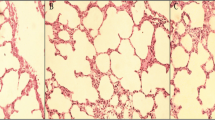Summary
To investigate the role of nitric oxide (NO) in hyperoxic lung injury, the 3-day-old preterm rats were randomly assigned to four groups: group I (hyperoxia group), groupI (hyperoxi-a+Nw-nitro-l-arginine methyl ester (L-NAME) group), groupI (air group), and group IV (air+ L-NAME) group. Group I and I were exposed to ≥90 % O2 for 3 or 7 days. GroupI and IV received subcutaneous L-NAMEy on daily basis (20 mg/kg). After 3 day or 7 day exposure, the lung wet weight/dry weight ratio (W/D), total protein and malondialdehyde (MDA) in bronchoalveolar lavage fluid (BALF) and lung pathology were examined in all groups. NO content, expression of endothelial NOS (eNOS) and inducible NOS (iNOS) in lungs were measured in group I andI. Our results showed that after 3 day exposure, group I appeared acute lung injury characterized by the increase of MDA content (P<0. 01) and the presence of hyperaemia, red cell extravasation and inflammatory infiltration; after 7 day exposure, except MDA, total protein and W/D were also increased in comparison with groupI (P<0. 01, 0. 05), pathological changes were more severe than those after 3 day exposure. After 3 and 7 day exposure, total protein in groupI was significantly increased as compared with group IP<0. 01 for both). The pulmonary acute inflammatory changes were more obvious in group I than in group I. Occasionally, mild hemorrhage was detected in the lungs of group IV. BALF protein content in group IV was higher than that in groupI after 7 day exposure (P<0. 01). After 3 and 7 day exposure, NO content in BALF were all significantly elevated in group I as compared with groupI (P<0. 01 for all). In the lungs of group I, strong immunostaining for iNOS was observed in airway and alveolar epithelia, inflammatory cells, which were stronger than those in groupI. Expression of iNOS in rats after 7 day hyperoxic exposure was stronger than that after 3 day exposure. Shortly after 7 day exposure, stronger immunostaining for eNOS in airway epithelia in group I than that in groupI was seen. Our study suggested that treatment with L-NAME worsened acute hyperoxic lung injury in preterm rats and also had a deleterious effect on the rats exposed to air, indicating that endogenous nitric oxide may play a protective role in rats under both physiological and hyperoxic status. Hyperoxia can significantly upregulate the expression of iNOS and eNOS in inflammatory cells, epithelia in the lungs of preterm rats, promote NO generation, which suggests that endogenous NO may mediate the hyperoxic pulmonary damage. Over-stimulation of iNOS may contribute to the pathogenesis of hyperoxic lung injury. NO may have dual roles in pulmonary oxygen toxicity.
Similar content being viewed by others
References
Potter C F, Kup N T, Farver C Fet al. Effects of hyperoxia on nitric oxide synthase expression, nitric oxide activity, and lung injury in rat pups. Pediatr Res, 1999, 45(1): 8
Radomski A, Sawicki G, Olson D Met al. The role of nitric oxide and metalloproteinases in the pathogenesis of hyperoxia-induced lung ingury in newborn rats. Br J Pharmacol, 1998, 125(7): 1455
Garat C, Jayr C, Eddahihi Set al. Effects of inhaled nitric oxide or inhibition of endogenous nitric oxide formation on hyperoxic lung injury. Am J Respir Crit Care, 1997, 155(6): 1957
Capellier G, Marpoil V, Boillot Aet al. L-NAME aggravates pulmonary oxygen toxicity in rats. Eur Respir J, 1996, 9(12): 2531
Tanswell A K, Wang L, Possmayer Fet al. The preterm rat: A model of acute and chronic neonatal lung disease. Pediatric Res, 1989, 25(5): 525
Saleh D, Barnes P J, Giaid A. Increased production of the potent oxidant peroxyniteite in the lungs of patients with idiopathic pulmonary fibrosis. Am J Res Crit Care Med, 1997, 155(5): 1763
Whittle B R. Nitric oxide in physiology and pathology. Histochemical J, 1995, 27(10): 727
Rodenas J, Mitjarila M T, Carbonell T. Nitric oxide inhibits Superoxide production by inflammatory polymorphonuclear leukocytes. Am J Physiol, 1998, 274(3): C827
Bechman T S, Koppenol W H. Nitric oxide, superoxide, and peroxynitrite: the good, the bad, and the ugly. Am J Physiol, 1996, 271(5): C1424
1997, 17(4): 203
Haddad I Y, Pataki G, Hu Pet al. Quantitation of nitrotyrosine levels in lung sections of patients and animals with actue lung injury. J Clin Invest, 1994, 94(6): 2407
Banks B A, Ishiropoulos H, Mcclelland Met al. Plasma 3-nitrotyrosine is elevated in premature infants who develop bronchopulmonary dysplasia. Peditrics, 1998, 10 (5): 870
Author information
Authors and Affiliations
Additional information
This project was supported by Hubei Science and Technology Department Foundation (No: 20002P16).
Rights and permissions
About this article
Cite this article
Liwen, C., Liya, M., Xiaohui, Z. et al. The role of nitric oxide in hyperoxic lung injury in premature rats. Current Medical Science 21, 78–81 (2001). https://doi.org/10.1007/BF02888045
Received:
Published:
Issue Date:
DOI: https://doi.org/10.1007/BF02888045




